

Pop-up notes are active on this page - Click any note number to view
| |

© David Hallam - 2019
|
The Twiggs Families of Beeston -
William Twiggs had originally moved to Nottingham, as a young man, to join the police force there and, in 1871, he was boarding on Sims Street, in the St Anns area of the town, while so employed 1.
At the same time, his wife-to-be, then Mary Ann Bywater, was boarding with her married sister Elizabeth's family in Arthur Place, in the Queens Road area of The Meadows, Nottingham, and working as a hosiery mender 2.
Mary Ann and her older sisters Elizabeth and Abigail were the daughters of Edward Bywater and his second wife Mary (née Scothern who had settled in Chilwell after their marriage in 1844. It was there that Mary Ann and her sisters were
born 3.
At some point over the next three years, William and Mary Ann became attracted to one another and were married on Christmas Day 1874 at St John's Church in the Leenside district of Nottingham. Possibly by this time and certainly by the following year, when their
first child was born, William had left the Police Force and was working as a 'sinker' 4 - most probably working at nearby Clifton Colliery which had opened on
 16 June 1870. Although the main shaft had, of course, been sunk by that date - the image (right) shows the sinking in progress in 1868 - it is
likely that he had found employment on similar work in the colliery's early days - perhaps working on a secondary shaft. 16 June 1870. Although the main shaft had, of course, been sunk by that date - the image (right) shows the sinking in progress in 1868 - it is
likely that he had found employment on similar work in the colliery's early days - perhaps working on a secondary shaft.
Around the time of their marriage, Mary Ann's sister, Elizabeth and her husband Frederick Thornhill moved to Long Eaton to live. Although, for a while, Mary Ann and William continued to live in the Leenside area of Nottingham, they clearly
valued the ties that existed within the families and, after Frederick Thornhill was killed in a terrible accident in July 1876, William and Mary Ann made the decision - certainly by September 1877, perhaps before - to move to Beeston where
they would be nearer Mary Ann's family. Their story and details of the accident are set out in the section covering the subsequent life in America of some of this family.
At first, William continued to work as a miner - presumably at Clifton Colliery - but, in 1879, he found employment with the Beeston Local Board as lamplighter at a wage of 16 shillings a week - with the cost of window leathers and matches
at his own expense! It was significant that he was chosen unanimously by the Board from several candidates who had applied for the job 5. That trust was certainly proved to be well placed,
as his employment was to continue, in various roles, for almost fifty years and was to earn him great respect for his versatility, hard work and dedication, both from his employer and the community
as a whole. Indeed, in these early days with the Board, his job took in other specific but specialised roles. As pinder he was responsible for impounding any stray cattle found in the village. using the pinfold that had stood at the western
end of what is now The Square, since ancient times, and which later became the site for the first Public Offices. He also served as the part-time Captain of the fire brigade in the years prior to the establishment of a more adequately equipped brigade
by Beeston Urban District Council. And, as town crier, he was occasionally called on to make public announcements, using the bell that continued to play a part at town occasions up to comparatively recent times.
When, in 1886, following the closure of the Churchyard to new burials, the cemetery was opened towards the northern end of what is now Wollaton Road, it was William who was entrusted with the role of sexton - a position he was to hold for twenty years both with his original employers, the Local
Board and with Beeston Urban District Council after it took over from the Board in 1894.
When the family first moved to Beeston - or soon afterwards - they are known to have lived in Union Street with Mary Ann's widowed mother and her now deceased sister's nine-year-old orphaned daughter, Mary Ann Thornhill 6.
Other Bywater family members lived nearby 7 - a further indication of the close relationships that were maintained within the Bywater/Thornhill/Twiggs families which, as we will see, continued into the future. By 1891,
William and his family had moved to live at 24 Chapel Street, Beeston 8, apparently a cottage associated with the adjacent school and Wesleyan chapel where William served as a caretaker in addition to his job with the
Council. Later, certainly by 1901, they moved to 42 Chapel Street 9 probably following the closure of the school and the chapel's pending move to their new premises in Chilwell Road which opened in 1902.
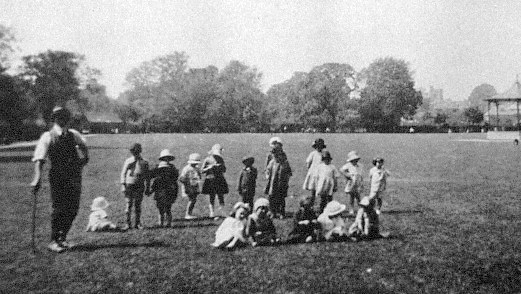 After about twenty years carrying out the duties of sexton, William had relinquished the role but continued to work for the Council in various roles. In particular he became a popular figure as the keeper at the Dovecote Road recreation ground in
Beeston, after it opened in 1908. The image on the right shows him in that role.
After about twenty years carrying out the duties of sexton, William had relinquished the role but continued to work for the Council in various roles. In particular he became a popular figure as the keeper at the Dovecote Road recreation ground in
Beeston, after it opened in 1908. The image on the right shows him in that role.
By 1911, the family had moved to 18 Clifton Street, Beeston 10 but moved to 8 Hampton Street, Beeston after the war, to live with their daughter, Mary Ann, and her children after the tragic death of Mary Ann's husband,
Arthur Matthew Smedley, on 7 June 1917, in France, while serving with the Sherwood Foresters. In December 1924 11, he and his wife celebrated their Golden Wedding and William retired from his employment with the Council
towards the end of the following year. For his faithful service over 46 years, a grateful Council found him 'very light work' for which he was paid £1 a week until his death on 13 December 1925, aged 75. He was buried in Beeston Cemetery, which he himself had cared for over many years
12. Sadly, no memorial survives.
Mary Ann, his widow, lived on for almost ten years before her death in 1935, aged 84 13.
William had served Beeston well and had been loyally and ably supported by his wife Mary Ann. Together they had raised a fine family, as is clearly shown in the family group photographs which follow. Also below, are details of this family, something
about the lives that they led and their own families.
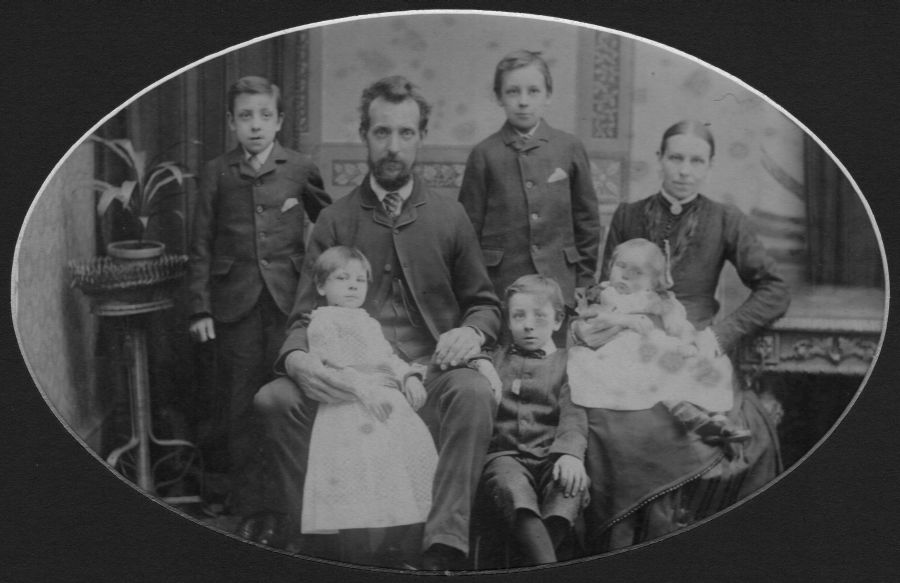
The above family group, taken in a local photographer's studio, shows William and Mary Ann with
their young family in about 1887. Standing at the back, between his parents, is their eldest child, William Edward (b. 1875).
Standing on the left is James (Jim), born in 1877. Sitting at the front, between his parents, is Ernest (b. 1881). Their eldest
daughter, sitting with her father, is Mary Ann (b. 1884, while baby Harriett Francis (b. 1887) is on her mother's knee.
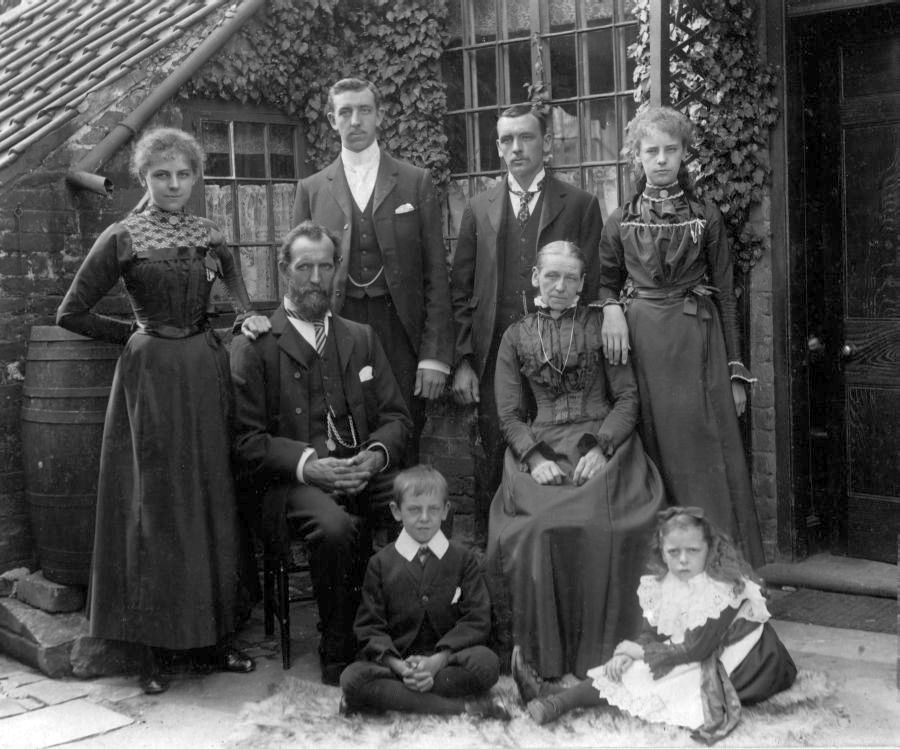
This family group, taken in about 1901, shows William and Mary Ann with their family in the backyard
of their then home at Chapel Street, Beeston. Standing at the back are their two eldest sons, William Edward, then aged about 26, on the right
and Ernest, aged about 20, on the left. Standing on the left is their eldest daughter, Mary Ann, aged about 17, and their daughter Harriett,
aged about 14, is standing on the right. In front is John, aged about 9 and Lily, aged about 7.
In total, William and Mary Ann had nine children although, as we will see, sadly not all were to survive beyond infancy.
William Edward Twiggs - was born on 7 November 1875 in Nottingham where his parents were then living, following their marriage almost a year
earlier. On 14 May 1876, he was taken to be baptised at St John's Church in Leenside, Nottingham, where his parents had married. He was aged about 2 when
the family moved to Beeston and would have attended school there, probably at the British School associated with the Wesleyan Chapel on Chapel Street. After
leaving school, he started work in the lace trade in the traditional way, as a threader but, by 1901, he was working as a railway policeman in London and
was boarding in Islington, London 14. However, in 1902, he married his cousin, Annie Maria Thornhill, an orphaned
daughter of William Edward's mother's sister Elizabeth 15, who William Edward would have known all his life. Their
subsequent life together - in England and in America - is described in the context of Annie Maria's life story, part of the next page, covering the Twiggs connected Thornhill family
and its American connections.
James (Jim) Twiggs - was born in Beeston in September 1877 and was baptised at the Parish Church there later that month. After school he started work at one of the local
nursery gardens. Sadly, he died of consumption in 1900, in Beeston, aged 23 16.
John Joseph Twiggs - was born in Beeston, probably in August 1880 and was baptised at the Parish Church there on 13 August. Sadly, he lived just a few weeks, and
died before the end of that year 17.
Ernest Twiggs - was born in Beeston shortly before his baptism in Nottingham, on 19 October 1881 18. After
school he worked as a porter on the railway and, by 1901, he was stationed in Sheffield where he was boarding with a number of other young men 19.
In 1902, he became a constable with the Sheffield City Police and, in 1907, married Harriett Ann Fearnehaugh who had been working as a children's nurse
in a household in nearby Dore 20. Their only child, Alice Francis Mary, was born in the following year 21
and, by 1911, they were living at 15 Hyde Road, Heeley, Sheffield 22. He was to serve with the police for a total of 26 years, including
the first 13 years in Central Division before promotion to Sergeant and transfer to Walkley Division. He retired in 1928, after serving in the Warrant Department for the last 7 years on his career He had become
a highly regarded police officer and was commended by the Watch Committee and by the Justices for meritorious conduct on several occasions and presented with a clock at his retirement 23.
Sadly, his retirement was short as he died in Sheffield in 1933, at the comparatively young age of 52 24. His widow and daughter moved
to Beeston where they lived out much of their lives at 36 Dennison Street. Alice, their daughter, who never married, worked in a drapery store. Harriett died in 1941 in Beeston and Alice
in April 1995 in Bramcote Nursing Home 25.
Ernest's baptism in Nottingham - in contrast to his older siblings' baptisms at the Parish Church - probably marks a turning point in his parents' religious affiliation as
the same location is recorded for several of their subsequent children's baptisms. Our source is not specific as to the actual church/chapel but we believe it is likely that the register
involved was one used for a Circuit - probably that of the local Wesleyan Methodist Church, given the family's ongoing connection with its chapel on Chapel Street, Beeston and
its successor on Chilwell Road, Beeston. Strangely, there are no Twiggs baptism recorded in the local registers for those chapels - but the baptism of at least two of Mary Ann
Bywater's siblings, then Chilwell residents, are recorded there.
|
Mary Ann Twiggs - was born in Beeston on 16 April 1884 and baptised in Nottingham, on 11 June 1884 26. After leaving school,
she worked as a lace mender before marrying Arthur Matthew Smedley in 1906 27. Arthur was the son of William, a well known hairdresser and
postman in Beeston, and his wife Emma (née Lowe) and had worked in the silk mill as a young boy but later started to work in the lace trade. In the early days of their marriage, the couple lived at
Draycott, Derbyshire where Arthur was probably working at the local lace factory and it was here that their daughter Lily was born in 1908 28
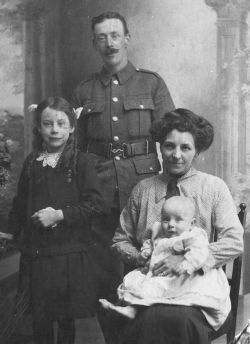 By 1911 they had moved to 17 Imperial Road, Beeston 29 but later moved to 8 Hampton Street (now known as Hampton Grove), Beeston which
continued as their family home and eventually became a home for members of the wider family. It was a happy family life but, when war came in 1914, everything changed. Arthur was
34 when the war started and, as a relatively old married man, he was not expected to be amongst those who rushed to enlist. But after conscription was introduced in 1916, and
extended to married men in May of that year, service was a requirement for men of his age and he is believed to have enlisted towards the end of 1916 with the Sherwood Foresters,
becoming part of the 11th (Service) Battalion. Sadly, he was required to leave his family so soon after the birth of the second child, William Arthur, who had been born on 17 July
1916 30. The poignant image (right) shows Arthur at the time of his Army training, in the autumn of 1916, standing proudly
with his family. Tragically, soon after this training he was killed during the Battle of Messines on 7th June 1917, after arriving in Belgium just a few weeks earlier. With no known grave, he
is remembered on the Menin Gate Memorial at Ypres, Belgium. Locally, he is remembered on the memorials in the Parish Church and Chilwell Road Methodist Church 31.
By 1911 they had moved to 17 Imperial Road, Beeston 29 but later moved to 8 Hampton Street (now known as Hampton Grove), Beeston which
continued as their family home and eventually became a home for members of the wider family. It was a happy family life but, when war came in 1914, everything changed. Arthur was
34 when the war started and, as a relatively old married man, he was not expected to be amongst those who rushed to enlist. But after conscription was introduced in 1916, and
extended to married men in May of that year, service was a requirement for men of his age and he is believed to have enlisted towards the end of 1916 with the Sherwood Foresters,
becoming part of the 11th (Service) Battalion. Sadly, he was required to leave his family so soon after the birth of the second child, William Arthur, who had been born on 17 July
1916 30. The poignant image (right) shows Arthur at the time of his Army training, in the autumn of 1916, standing proudly
with his family. Tragically, soon after this training he was killed during the Battle of Messines on 7th June 1917, after arriving in Belgium just a few weeks earlier. With no known grave, he
is remembered on the Menin Gate Memorial at Ypres, Belgium. Locally, he is remembered on the memorials in the Parish Church and Chilwell Road Methodist Church 31.
Life as a widow with two young children would have been difficult but, at least Mary Ann had the support of the family and her local Methodist Church friends. Her elderly parents moved
to live with her at Hampton Street (later known as Hampton Grove), up to their deaths in 1925 and 1935 respectively. Mary Ann remained a widow for the remainder of her life, and stayed close to the
family. In 1939, she was living at 11 Hampton Grove, Beeston with her daughter, who was working as a sorting clerk and telephonist, and her sister Harriett. Her recently widowed cousin, Mary
Ann Hudston (née Thornhill) was staying with them 32. Mary Ann was to die there on 6 April 1958, aged 74. Lily remained single
and died on 21 September 2009, aged 101. William Arthur was employed all his working life with Beeston Boiler Company, starting as a 14 year old office boy in 1930, being the type of promising and
deserving young men whom the Pearson family tended to employ. He went on to become the company's Sales Director, served the company well until its final closure in 1985 and, in addition, was an active
and popular figure within the wider Beeston community 33. He married Dorothy Sansom in 1940 and the couple had one daughter.
William Arthur died in on March 1994, aged 77; Dorothy died on 2 April 2002, aged 86 34.
Harriett Frances Twiggs - was born in Beeston on 15 February 1887 and baptised in Nottingham, on 6 March 1887. She remained unmarried throughout her life, living with her parents and then with
her siblings and, for much of this time, working as a lace mender. She died on 12 February 1981, aged 93. 35
Horace Twiggs - was born in Beeston early in 1890 and baptised in Nottingham, on 6 July 1884 but sadly died early in 1893 36.
John Twiggs - was born in Beeston on 1 March 1892 37. For the whole of his working life, he was employed in the grocery trade
with the Co-operative Society, first as an assistant in the Beeston store and later in more senior positions. Although, he is believed that took him beyond Beeston at some time - to Cardiff, it is believed,
at the time of his father's death in 1925 - Beeston remained his home for most of his life. In 1919, he married Louise Lawrence, the daughter of Henry Lawrence, a lace maker, and his wife Louisa (née
Fisher) 38. At first, the couple appear to have lived at 18 Clifton Street, Beeston with the Twiggs. Their only child, Ralph, was born
towards the end of 1924 but died after only a short life, at the beginning of 1925 39. After
their apparent move to Cardiff, they were living at 43 Middleton Street, Beeston by 1930 and at 29 Warwick Avenue, Beeston by 1929 40.
In retirement, in 1957, John and Louise visited America and Canada. By then, the couple had moved to 6 Hampton Grove, Beeston, where John died on 5 September 1975. Louise died on 9 July 1977 having moved
to sheltered accommodation at 5 Bexhill Court, Beeston 41.
Lily Twiggs - was born in Beeston in 1894 and had a brief life, blighted by consumption, before her death, aged 9, in 1903 42.
In 1927, William Edward Twiggs visited from America and the opportunity was taken to photograph the whole family, in the garden at 11 Hampton Grove, Beeston :
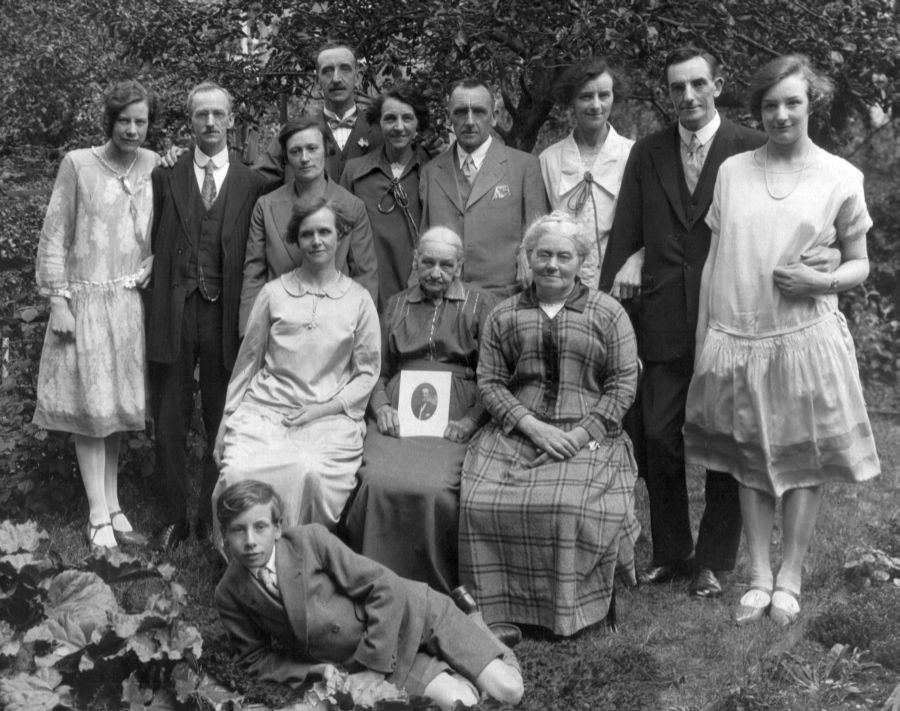
Standing, left to right, are Lily Smedley, Leonard Hudston, Louise (Lawrence) Twiggs, Ernest Twiggs, Mary Ann (Twiggs) Smedley, William Edward Twiggs, Harriett Frances Twiggs, John Twiggs, Alice Frances Mary Twiggs.
Seated : Harriett Ann (Fearnehough) Twiggs, Mary Ann (Bywater) Twiggs (Holding a photograph of William, her late husband), Mary Ann 'Polly' (Thornhill) Hudston,
In front is William Arthur Smedley
Use the side menu or click here to explore more about this family.
We are extremely grateful to Christine Smedley for making available her Twiggs family album and other family information.
Notes
Return to Top of This Page
© David Hallam - 2019
All information relates to the specific individual and/or family shown
and and does not necessarily relate to other individuals or families with the
same surname.
Whilst every effort is made to ensure that information is as
accurate as possible, as in all genealogical research, users should satisfy
themselves as to its accuracy.
We do not knowingly include information relating
to living individuals. |
|
 |
|